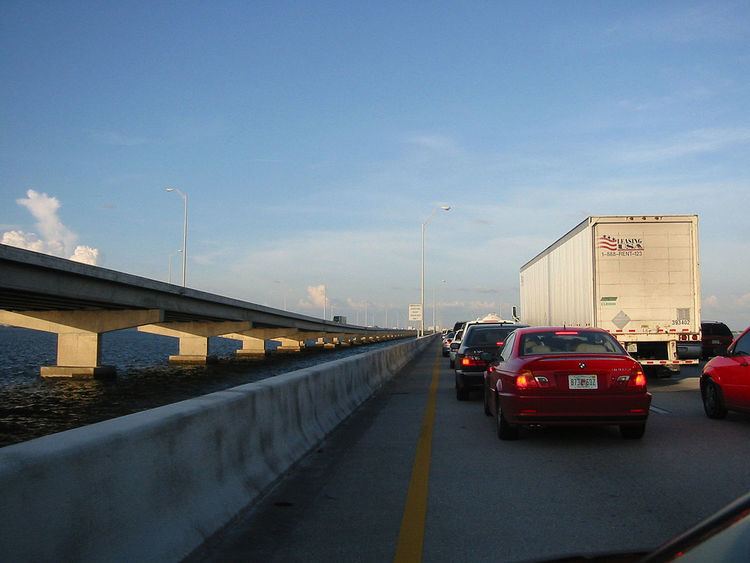Total length 4,846 m Opened April 1960 | Construction started June 1957 Clearance below 15 m Location Tampa, St. Petersburg | |
 | ||
ID number 150107 (northbound) 150210 (southbound) Width 58.4 feet (17.8 m) (northbound)68.9 feet (21.0 m) (southbound) Similar | ||
Flying over the w howard frankland bridge tampa bay florida
The W. Howard Frankland Bridge is the central bridge spanning Old Tampa Bay from St. Petersburg, Florida to Tampa, Florida. It is one of three bridges connecting Hillsborough County and Pinellas County; the others being Gandy Bridge and Courtney Campbell Causeway. The bridge carries Interstate 275 and is by far the most traveled of the bay's bridges.
Contents
- Flying over the w howard frankland bridge tampa bay florida
- Drive across tampa bay on the howard frankland bridge interstate 275 aka i27 howard franklin
- History
- Bypass system
- Reconstruction of the bridge approaches
- References
The bridge is often incorrectly referred to as the Howard Franklin Bridge.
Drive across tampa bay on the howard frankland bridge interstate 275 aka i27 howard franklin
History
Named for the man who proposed it, Tampa businessman Howard Frankland, the bridge opened in April 1960 and carried four lanes (two lanes in each direction separated by a short, narrow barrier). The bridge and approaches cost $16 million.
Because of the bridge's design, including its lack of emergency shoulders, it proved to be dangerous. Accidents were common on the bridge and traffic backed up on both sides, leading to local nicknames, the "Howard Frankenstein Bridge" and "The Car-Strangled Spanner". In 1962, a steel-reinforced tapered concrete barrier was installed "to prevent cars from hurtling the median and crashing into oncoming traffic." Ten people had already died. The bridge was the subject of a 60 Minutes broadcast in the 1960s noting the below-average construction methods used.
Planning for a larger-capacity replacement began in 1978. Original plans ranged from a large, multi-lane suspension (or similar type) bridge, to two parallel bridges (with the central span reserved for HOV lanes). As traffic projections increased, further exacerbated by a disaster on the Sunshine Skyway Bridge in 1980, it was clear that the new bridge would need to handle at least eight lanes (four in each direction). By 1987, it was concluded that a parallel, four lane span would be built. Plans were also made to rehabilitate the older bridge after the new bridge opened.
Construction began on the new span in 1988. The new $54 million southbound span was opened to traffic in 1990. The older bridge was then closed, rehabilitated, and reopened in 1992. The older northbound span is shorter and has a steeper hump than the newer southbound span.
Bypass system
Before the parallel bridge was built, I-275 utilized a bypass designation system. Whenever there would be a major delay at the Howard Frankland Bridge, special signs would alert drivers to the delay and direct them to utilize the bypass, which ran along SR 694 and across the Gandy Bridge, to the Lee Roy Selmon Expressway, Willow Avenue, Howard Avenue, and ending at Interstate 275. Special shields (marked N and S) along the route made sure that drivers were using the correct thoroughfare.
Reconstruction of the bridge approaches
After the widening project in 1992, Interstate 275 was increased to eight lanes on the bridge itself. However, this did not increase capacity on either end of the bridge. Backups were still seen on the Howard Frankland heading into Tampa, primarily due to a bottleneck at the SR 60/Veterans Expressway exit. On the St. Petersburg side, after a comprehensive reconstruction project that took over ten years, lane counts were increased from four lanes prior to the bridge to six lanes through downtown St. Petersburg, and eight lanes from Gandy Boulevard to the bridge.
A reconstruction project was planned to begin in 2007 for I-275 between the Howard Frankland and downtown Tampa. However, due to rising cost of materials, FDOT planned to reconstruct the interstate in smaller phases rather than the original larger two-phase project. Once the reconstruction project is finished (about 2013), major traffic congestion on the Howard Frankland is expected to be significantly reduced.
